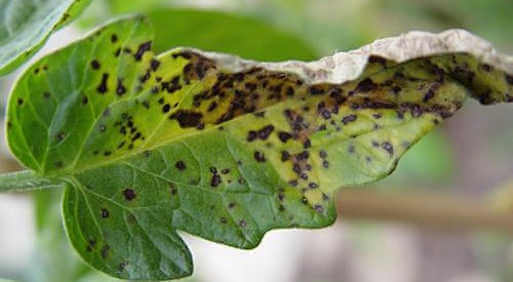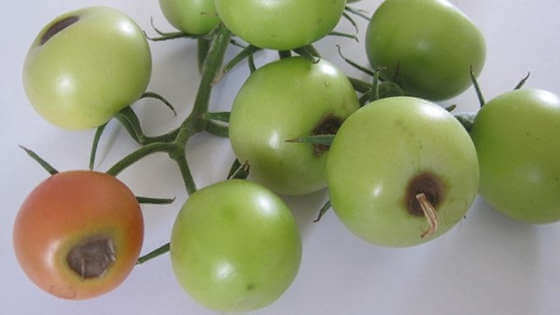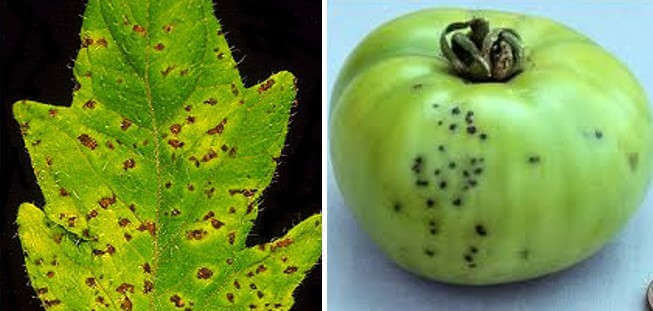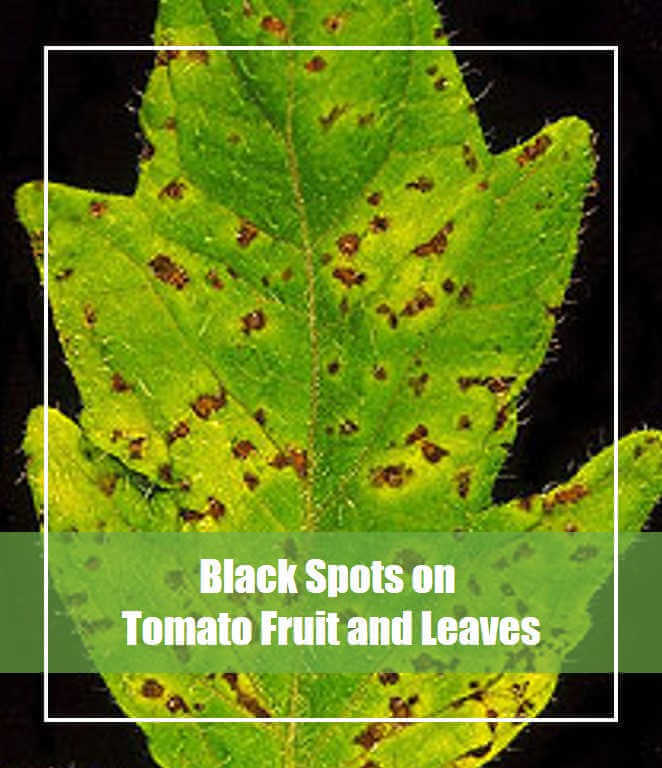Growing fresh tomatoes is a true joy for a vegetable gardener. However, tomatoes can suffer from all kinds of diseases and pests. Causes are often connected to weather conditions that cannot be handled.
When you know that your region is vulnerable to a certain disease, you can look for varieties that are categorized as resistant. Tomato diseases are rarely fatal when you take time management steps.
Each disease has its own traits, some attack the foliage, and some attack the fruit. If you ever find any black spots on tomato fruit and leaves, then there is a very good chance that it has either Septoria leaf spot or blossom end rot.
You should always catch a disease early before it spreads to any other plants. For a tomato plant, it can transfer to plants like potatoes, eggplants, and peppers. So, if you don’t want to see your garden in its ruins then it’s crucial to find a solution to it.
In this article, you’ll find everything you need to know about these two diseases. So, let’s dive right in.
The Causes of Black Spots of Tomato Leaves
septoria leaf spot and bacterial speck may be the cause of black spots of tomato leaves. Let’s see the symptoms and control measures of those diseases.
#Septoria Leaf Spot

Septoria leaf spot, also known as Septoria blight, is a very widespread tomato disease. It’s a fungus (Septoria lycopersici) lead disease.
So, how much impact can it make?
Well, it can affect tomatoes and other plants of the Solanaceae family, particularly potatoes and eggplant, just about anywhere in the world.
While Septoria leaf spot isn’t necessarily fatal to your tomato plants, it spreads rapidly and can defoliate and weaken the plants easily, making them unable to bear fruit to maturity.
The Lifecycle of Septoria Leaf Spot
In wars, there’s a tendency to know each and every detail of the enemies. The case is the same here. So, let’s look at how the whole deal-
Fungal spores can persist and live in infected plant debris. The fruiting bodies, or pycnidia, may also be buried and lie in wait in the soil itself. Often those spores book a flight to other plants in your garden.
Wind or splashing water will hold those spores on your plant’s lower leaves. Insects can also disperse spores, unintentionally.
So, what happens next?
These spores are stuck to leaves, which in turn gives birth to the to appear slowly. These spots will be typical, with a greyish middle and brown edge.
The lesion core on the leaves includes the pycnidia, the fungal fruiting bodies. The pycnidia are where spores are produced. These fruiting bodies will work their way into the soil as the damage to the lower leaves becomes extreme, and they fall.
This means the spores can be re-spread later through the transmission of water, wind, or insects, or even on human hands or tools.
During periods of warm and wet or humid weather, the fungi get in its best form. So, these fungi slowly create spots.
As a result, the spots mostly occur during the spring and can occur all summer long.
However, in the fall and winter, it is less normal, as the weather is less conducive to sporulation.
Symptoms of Septoria Leaf Spot
Septoria leaf spots begin rather circular and first appear at the bottom of the plant, on the undersides of older leaves. Tiny black spots on the underside of leaves appear.
They are small in diameter. To be more specific, these are around 1/16 to 1/8 inches (1.6 to 3.2 millimeters), with a dark brown margin and lighter gray or tan centers.
The spots may grow larger as the disease progresses. You might even see the spots merging together. If you see them through a magnifying lens you can see the fungi ‘ fruiting bodies, which look like dark brown pimples.
It’s one of the symptoms which distinguish Septoria leaf spot from other diseases of leaf spotting.
Although the symptoms typically appear in the older, lower leaves, at any point in the life of the tomato plant the disease may develop. And when that happens, these can also appear on roots, as well as on calyxes and blossoms. A little bit of good news— it rarely affects the fruits.
When untreated, the leaf spot Septoria causes yellow leaves with black spots on tomato plants and gradually dry out and fall off. This will weaken the plant, send it into decay, and cause the vulnerable, exposed tomatoes to be scalded by the sun. The plant will not continue to grow and mature tomatoes, without leaves. Septoria leaf spot easily spreads.
Treatment for Septoria Leaf Spot
You can follow a few methods when treating Septoria Leaf Spot. Let’s have a look.
Removals of Infected Plants
Immediately remove infected leaves, and make sure to wash your hands thoroughly before dealing with uninfected plants.
Organic Fungicide
Which contain either copper or potassium bicarbonate will help prevent the disease from spreading. Start spraying as soon as the first signs emerge and follow the instructions for continued management on the label.
Here is the recommended organic fungicide for your tomato plants–
Chemical Fungicides
While chemical solutions aren’t ideal, they might be the only way to combat advanced infections. Chlorothalonil is one of the least toxic and most powerful.
Here is the recommended chemical fungicide for your tomato plants-
Prevention of Septoria Leaf Spot
You may not be able to stop the Septoria leaf spot entirely. It’s very widespread and will try to take root in your backyard, despite the perfect conditions. However, there are a few steps that you can take to lower the risk of a Septoria leaf spot.
Using Seed which is Disease Free
There is no proof that seeds bear it, but it is better to be on the safe side. Be sure to use perfectly healthy seeds and inspect them before using them.
Start with a Tidy Garden
Be sure to have all affected plants disposed of. The fungus does not live in the soil but on the debris of diseased plants, it will overwinter. So, disposing of all the affected plants far away from the garden and the compost pile is required. Bear in mind that it might also have spread to your potatoes and eggplants.
And don’t use the same potting soil again. Use fresh and diseases free soil mix for planting the new tomatoes.
Stop Watering Overhead
Water helps the spread of the Septoria leaf spot. Keep as much of it off the leaves as possible by watering only at the plant base. Of course, keeping the rain off your plants is difficult but every little bit helps.
Provide Space for Air Circulation
Leave some space between the tomato plants so the airflow is fine. Stake them so they don’t hit the ground and not all bundled together. Good air circulation is especially important during periods of humidity and rain.
Mulch from under the crop
A mulch layer can avoid spores splashing up onto the lower leaves on the ground.
Plant the tomatoes from next year in another part of your yard
In small gardens, rotating your crops is not always feasible so good cleaning and sanitation become even more important.
The Causes of Black Spots of Tomato Fruits
There are two diseases of tomato that may the cause of black spots on tomato fruits. Blossom end rot and bacterial speck of tomato. In this section, I will talk about those diseases symptoms and control measures.
#Blossom End Rot

A common problem affecting many home-grown vegetables is Blossom end rot (BER). Blossom end rot usually causes premature ripening of the fruit, resulting in inedible fruit. It is caused by a calcium deficiency and can be handled with proper soil control and watering.
Causes and Identification of Blossom End Rot
When you see black spots on your tomatoes then you will most likely be dealing with a disorder called blossom end rot. It is a very common issue that tomato gardeners face.
Blossom end rots tend to occur when the season for growing tomatoes starts out wet. When the fruits are around half their full size you will start to notice the rot.
Healthy calcium intake is required for vegetables and fruits such as tomatoes to grow. The tomato’s blossom-end will begin to break down when calcium is missing.
Calcium shortage may be caused by a variety of factors such as fluctuation of moisture, low-pH soil, or the presence of excess fertilizer.
Although pests don’t contribute directly to blossom end rots, you might want to take the necessary measures to keep them at bay. Common pests of tomatoes may include flies, slugs, and caterpillars.
Prevention of Blossom End Rot
It is always too late to salvage fruits affected by BER. However, you can always take some steps to prevent it from happening.
Rate of pH in soil
The pH of the soil should not be either acidic or alkaline. Of tomatoes, the optimum pH level is between 6.2 and 6.8. This soil condition would cause more calcium to be brought into the tomato plant.
Here is the pH meter that can help you determine the soil pH-
Usage of fertilizers
Don’t use too much fertilizer. Too much nitrogen can bind the calcium to the soil chemistry, particularly during the early fruiting stage.
Stress in the humidity
The soil should remain consistently moist. One way to maintain a degree of moisture even is to add mulch over the soil. Mulch has the ability to mitigate soil evaporation.
Usage of lime
If your soil is low in calcium (as determined by the soil test), the easiest solution is to add lime several times a year as needed.
A popular blossom end rot treatment is to spray a calcium solution on the leaves, stems, and fruit. This usually does little for the plant, because calcium is absorbed primarily from the soil. If the problem is really calcium deficiency in the soil, then soil alteration with lime or bone meal is the best remedy.
However, calcium spray can be used as a temporary measure of tomato plants. Calcium sprays can be made from calcium nitrate or calcium chloride at home.
#Bacterial Speck of Tomato

Bacterial speck is the most common disease of tomato caused by Pseudomonas syringae pv. At the early stage, it affects the leaves and reduces production. Later, it attacks fruits and impacts on tomato quality.
Causes and Identification of Bacterial Speck of Tomato
At the early stage, approximately ⅛ to ¼ inch in diameter black spots appear on the tomato leaves that often are more noticeable on the undersides of leaves. After several periods of time, the black spots develop a yellowish halo.
The spots may prominent to the fruits, the spots become raise on the fruits and turn color from brown to black. If you notice very carefully, then you may be seen a green halo around the spots on unripe tomato and yellow halo on ripe tomato.
Prevention of Bacterial Speck of Tomato
Prevention is the only way to keep safe your tomato from the bacterial speck. You should maintain the following steps to prevent this disease-
Use disease-free seed
This is a seed-borne disease. It can mostly spread through seed. So planting healthy and disease-free seeds may be the primary step of prevention the speck disease.
Seed treatment
Soak the tomato seed in hot water (52°c) for 25 minutes or you can also soak seeds in a 20% bleach solution for 30 minutes.
Chemical Control
Spray mancozeb or maneb fungicide to prevent this disease. You can also mix copper bactericide with the fungicide.
Here are the recommended copper bactericide and mancozeb fungicide for you-
Lastly, Sterilize the gardening tools with 10% bleach or rubbing alcohol and don’t use sprinkler water the tomato. If you notice any symptoms of this disease, cut the infected parts and buried in a safe place. In severe condition, burn the whole plant.
The Bottom Line
Learning how to grow tomatoes is becoming more popular day-by-day. But nothing ruins a homemade crop of tomatoes quicker than diseases like blossom end rot and Septoria leaf spot. I hope this guide will help you prevent and treat diseases like these. Good luck!
Read More


